The Tuskegee Airmen have become one of the most celebrated units in WWII history. One of the world’s foremost authorities on the unit hails from New Orleans and studied with our two founders, Drs. Stephen Ambrose and Nick Mueller, at the University of New Orleans. Daniel Haulman, PhD, was the longtime Chief of Organizational History Division at the Air Force Historical Research Agency. The author of 10 publications and countless articles, Dr. Haulman was kind enough to take some time to answer some questions.
Daniel Haulman, PhD (center) with (L-R) Craig Huntly, historical researcher; Tuskegee Airman Col. William Holloman; Tuskegee Airman Lt. Col. George Hardy, and Tuskegee Airman Lt. Col. Alexander Jefferson.
For those who are unfamiliar with them, can you give a brief description of who the Tuskegee Airmen were?
The Tuskegee Airmen were the first African American military pilots in United States military service, and those who belonged to their squadrons and groups, and those who were stationed at their training and combat bases when they were there. There were 992 Tuskegee Airmen pilots trained at Tuskegee, including single-engine fighter pilots, twin-engine bomber pilots, and liaison and service pilots, but the total number of Tuskegee Airmen, counting ground personnel such as aircraft mechanics and logistical personnel, was more than 14,000.
The Tuskegee Airmen were also the first African American military pilots in American military service to deploy to a combat theater overseas, and to engage in combat, and to shoot down enemy aircraft. The Tuskegee Airmen pilots are most remembered for flying fighters in the Mediterranean theater, first for the Twelfth Air Force, under which they flew hundreds of missions, then for the Fifteenth Air Force. While flying for the latter, the 332d Fighter Group and its 99th, 100th, 301st, and 302d Fighter Squadrons flew primarily bomber escort missions, and gained a reputation for excellence. Between early June 1944 and the end of April 1945, the Tuskegee Airmen flew 312 missions, 179 of which were bomber escort missions. They lost escorted bombers to enemy aircraft on only seven of those missions.
The total number of Tuskegee Airmen-escorted bombers shot down by enemy fighters, by my research, was 27, while the average number lost by each of the other six fighter escort groups in the Fifteenth Air Force was 46. The Tuskegee Airmen lost significantly fewer bombers to enemy aircraft than the average of the other groups. Many of their missions were flown in red-tailed P-51 Mustangs, and for that reason they are sometimes called the “Red Tails.” Other Tuskegee Airmen served in the 477th Bombardment Group and its assigned 616th, 617th, 618th, and 619th Bombardment Squadrons, but those organizations never deployed overseas for combat during World War II.
1943 War Bond Poster featuring Black Airman courtesy of the National Archives and Records Administration.
What was the motivation behind the United States forming this group?
In 1940, President Franklin D. Roosevelt was running for an unprecedented third term as President, and during his campaign, he promised to allow Black pilots to train to serve in the Air Corps. In accordance with Roosevelt’s policy, the War Department announced in early January 1941 that it would begin training African American pilots in the Army Air Corps, and the place they would be trained would be Tuskegee, Alabama. The first Black flying unit, the 99th Pursuit Squadron, later the 99th Fighter Squadron, was constituted and activated in March 1941 at Chanute Field, Illinois, but it did not yet have its pilots. Later that year, after training of the ground crews, the squadron was moved to Tuskegee where its pilots would be trained.
Tuskegee was selected partly because it was in the South, which had more days of good flying weather, and partly because Tuskegee Institute was already training Black civilian pilots successfully. In late March 1941, Eleanor Roosevelt, wife of the President, visited Tuskegee and flew with a Black pilot at the civilian pilot training facility of Tuskegee Institute. She supported her husband’s decision to train Black military pilots to serve in the Army, but, by the time of her flight, the first Black flying unit had already been formed, and the plans for Tuskegee flight training had already been developed. Contrary to popular belief, she did not talk her husband into the policy after having flown with a Black pilot at Tuskegee.
Eleanor Roosevelt with Tuskegee Airmen, March 1941. Courtesy of the FDR Presidential Library and Museum.
Were there objections or unique obstacles to this unit being formed?
Objections to the plans for Black military pilots came from different sources and for different reasons. Some leaders of the War Department and the Air Corps resisted efforts to train Black military pilots, partly because they believed Blacks to be inferior, and partly because pilots were officers, and they did not want Black officers over white enlisted men. They implemented Roosevelt’s policy, but planned to train the Black pilots separately from the white pilots training at other bases. The Black flying units would eventually be all-Black, after initial white leadership.
The National Association for the Advancement of Colored People (NAACP) wanted integrated pilot training instead, and initially opposed the establishment of segregated Black flying training at Tuskegee. The NAACP eventually supported the Tuskegee flight training program, because its members realized that it would be better to have segregated Black military flight training than to have no Black military flight training. Some of the white officers at Tuskegee Army Air Field were very supportive of the Black military flight training. Others in higher places were not eager to see the Black military pilots serve in combat overseas, after they were trained, and resisted their deployment.
Did the Tuskegee Airmen experience particular differences or problems in training, or did they receive the same as white airmen?
Colonel Noel F. Parrish commanded Tuskegee Army Air Field during most of World War II, and was commander of the basic and advanced flight training there. He insisted that the training of Black pilots be of the same quality as the training of white pilots at other bases. Only about half of the Black flight cadets who entered the flight training completed that training, but the almost 1,000 pilots who did graduate were as fully qualified as any white pilots going through the same sequence of training at other bases. Sometimes the training program was criticized because so many of the cadets “washed out” or failed to complete flight training and get their wings, but those who did graduate were grateful that the standards were high, and that they had fulfilled them.
Their excellent training paid off when they flew combat missions overseas. The Black flying cadets had primary flight training at Tuskegee Institute’s Moton Field, with Black civilian flight instructors, but the basic and advanced flight training at Tuskegee Army Air Field, where all of the flight instructors at first, and the majority throughout the war were white. Those white flight instructors followed Colonel Parrish’s high standards. The washout rate at white flight training bases was also high. There is some evidence that the Black civilian flight instructors at Tuskegee Institute’s Moton Field were more lenient than the white flight instructors at Tuskegee Army Air Field, but there is also evidence that the relationship between the white flight instructors and the Black cadets at Tuskegee Army Air Field was generally cordial and respectful. Some of those who failed to complete the military flight training blamed other factors than their own performance.
Was it always a part of the War Department’s plan to send the Airmen on overseas service? Were there specific considerations as to where they would deploy to and what type of missions they were assigned?
Once enough Black military pilots were trained at Tuskegee, they were assigned first to the 99th Fighter Squadron, and later to the 100th, 301st, and 302d Fighter Squadrons of the 332d Fighter Group. None of the squadrons or the group deployed to combat overseas as soon as they received enough pilots to be fully operational, and there were some complaints about how long it was taking for them to be sent into combat overseas. In the spring of 1943, the Army Air Forces finally sent the first Black flying unit, the 99th Fighter Squadron, to North Africa, and later to Sicily and then to the mainland of Italy, later in the year, but because at first there was no Black fighter group overseas to which it could be assigned, it was attached to various white fighter groups, each of which already had three white fighter squadrons assigned to it.
One of those white fighter group commanders, Colonel William Momyer of the 33rd Fighter Group, sent a memo up the chain of command complaining that the Black fighter squadron attached to his group was performing poorly, and requesting it be taken out of flight line combat. The War Department launched a study to compare the 99th with the other P-40 fighter squadrons that were flying for the Twelfth Air Force at the time, and concluded that the 99th was flying just as well as the white fighter squadrons.
The War Department, in early 1944, also deployed the 332nd Fighter Group and the other three Black fighter squadrons to Italy, and they, like the 99th, at first flew missions in support of surface forces for the Twelfth Air Force. In the middle of 1944, the 99th Fighter Squadron, which had been flying P-40s, and the 332nd Fighter Group and its 100th, 301st, and 302d Fighter Squadrons, which had been flying P-39s, were reassigned to the Fifteenth Air Force to help provide fighter escorts for its B-17 and B-24 four-engine heavy bombers. That gave the Tuskegee Airmen more opportunity to engage the enemy, over enemy territory, to shoot down more enemy aircraft, and to demonstrate their proficiency escorting bombers. For those bomber escort missions, the Tuskegee Airmen at first flew P-47 and then P-51 aircraft, which were faster and more maneuverable than the types of fighters they had flown before. When the 99th Fighter Squadron was assigned to the 332nd Fighter Group, it had a total of four fighter squadrons, more than the three squadrons of the other fighter groups in combat. In other words, eventually the Tuskegee Airmen’s fighter group, the 332nd, was the largest fighter group in the Army Air Forces.
The Tuskegee Airmen are some of the most celebrated individuals from World War II. What are some of their crowning achievements?
Col. Benjamin O. Davis, Jr., Sicily 1943 courtesy of the US Army Air Force.
There were many outstanding Tuskegee Airmen. Colonel Benjamin O. Davis, Jr., who commanded the 99th Fighter Squadron, then the 332nd Fighter Group, and then the 477th Composite Group, was a graduate of the United States Military Academy at West Point, and the son of the Army’s first Black general. Colonel Benjamin O. Davis Jr. later became the first Black general in the United States Air Force. In 1945, he became the first Black base commander in the United States, and in 1947, the first Black wing commander in the Air Force. The second most famous of the Tuskegee Airmen was General Daniel “Chappie” James. Although he did not serve overseas in combat during World War II, because he then belonged to the 477th Bombardment Group (predecessor of the 477th Composite Group), he remained in the Air Force after that war, and served in Korea and Vietnam. He rose to become the first Black four-star general in the Air Force or any of services.
The first three Black generals in the Air Force, which became independent from the Army in 1947, were Tuskegee Airmen.
Although none of the Tuskegee Airmen became aces, Colonel Lee Archer was one of three Tuskegee Airman to have shot down a total of four enemy aircraft, and one of four Tuskegee Airmen to have shot down three enemy airplanes in one day. Colonel Roscoe Brown was one of three Tuskegee Airmen to have shot down a German Me-262 jet, despite the fact that the jet was much faster than the P-51s the Tuskegee Airmen flew at that stage of the war.
Tuskegee Airmen shot down a total of 112 enemy airplanes in World War II. Another famous Tuskegee Airman was Brigadier General Charles McGee, who flew a total of 409 fighter combat missions in World War II, Korea, and Vietnam, flying at least 100 such missions in each of those wars. Lieutenant Colonel George Hardy was another Tuskegee Airman who flew in all three of those wars, but he flew fighters in World War II, bombers in Korea, and gunships in Vietnam.
The Tuskegee Airmen earned a total of 96 Distinguished Flying Crosses during World War II, and the 99th Fighter Squadron earned a total of three Distinguished Unit Citations.
In 2007, President George W. Bush unveiled a Gold Medal Congress had authorized the previous year, to honor all of the Tuskegee Airmen collectively for their WWII service.
Living Members of the Tuskegee Airmen receive at the Congressional Gold Medal ceremony with President George W. Bush, March 2007.
What are some misconceptions of the Tuskegee Airmen?
The most common of the false claims about the Tuskegee Airmen is the claim that on their bomber escort missions, they “never lost a bomber” to enemy fighters. At least 27 bombers under Tuskegee Airmen escort were shot down by enemy airplanes. Another false claim is that Tuskegee Airman Lee Archer was an ace who shot down five enemy airplanes, but that one of his aerial victory credits was reduced by half or taken away by racists who did not want a Black ace. The truth is that Lee Archer claimed to have shot down a total of four enemy airplanes during World War II, and he received credit for all four of them, one on July 18, 1944, and three more on October 12, 1944.
Another false claim is that Tuskegee Airman Roscoe Brown was the first American pilot to shoot down a German jet. The truth is that many other American pilots shot down German Me-262 jets before Roscoe Brown did. In fact, Brown was one of three Tuskegee Airmen pilots to shoot down German jets on March 24, 1945, and he might have not been the first Black pilot to do so, either. Another false claim is that the Tuskegee Airmen sank a German warship on June 25, 1944. Records show that the only German warship struck by American aircraft at the same time and place was the TA-22, a former Italian destroyer called the Giuseppe Missori, and it did not sink that day. In fact, although the ship was severely damaged, it remained afloat until it was scuttled the next year. Still one more false claim is that Tuskegee Airman Charles McGee flew more combat missions in three wars than any other Air Force pilot. At least two other Air Force fighter pilots flew a total of more combat missions in the same three wars as General McGee. Each of them flew more than 600 missions, whereas McGee flew 409.
Victory in World War II Is traditionally seen as a glorious accomplishment and the veterans returning home to a liberated world and better country. Was this the typical experience for Tuskegee Airmen?
Many of the Tuskegee Airmen remember returning home by ship after the conclusion of the war in Europe, and some of them recalled not getting any kind of welcome. In fact, most, if not all of them, returned on ships with white combat veterans on the same vessel, and most, if not all, of these vessels were welcomed when they returned to the United States. However, some of the Tuskegee Airmen remember that once the ship docked, Black personnel were sent in different directions than white personnel, which reminded some of them of the racially unjust segregation that remained in the United States.
When they returned home, most of them regretted that their excellent performance overseas was not more recognized, except among their own families and what was called the Black Press (African American newspapers such as The Chicago Defender and The Pittsburgh Courier.) Many of the Tuskegee Airmen thought their accomplishments had been ignored by most white Americans, and segregation continued to plague the United States as a whole, even in the military. The first book about the Tuskegee Airmen, a book called The Tuskegee Airmen by Charles Francis, was published in the mid-1950s. Francis coined the term “Tuskegee Airmen.” The Tuskegee Airmen veterans later formed an organization now called the Tuskegee Airmen Incorporated, to preserve their legacy and encourage others to follow in their footsteps.
Many of the Tuskegee Airmen believed that, when President Harry S. Truman issued his Executive Order 9981 in 1948 to desegregate the United States Armed Forces, one reason was because of their accomplishments. Certainly the Air Force was already training Black and white pilots together at Williams Air Force Base, Arizona, by the time the Air Force deactivated the all-Black flying units in 1949 and became more fully integrated. Many of the former Tuskegee Airmen became active participants of the Civil Rights Movement in the 1950s and 1960s. The first Black mayor of Detroit, for example, Coleman Young, had been a Tuskegee Airman in the 477th Bombardment Group. He had been arrested in April 1945 at Freeman Field, Indiana, for attempting to desegregate the white officers club there.
What is the legacy of the Tuskegee Airmen in the postwar years, and today?
The Tuskegee Airmen have become famous as the first African American pilots in United States military service, who proved that Black men could fly advanced aircraft in combat as well as their white counterparts. The first Black commander of an Air Force fighter squadron was a Tuskegee Airman. The first Black commander of an Air Force fighter group was a Tuskegee Airman. The first Black commander of an Air Force bombardment group and bombardment squadron was a Tuskegee Airman. The first Black commander of an Air Force base was a Tuskegee Airman. The first Black commander of an Air Force wing was a Tuskegee Airman. The first three Black generals in the Air Force (Benjamin O. Davis Jr., Daniel “Chappie” James, and Lucius Theus) were all Tuskegee Airmen. The first Black four-star general was a Tuskegee Airman. The Tuskegee Airmen shot down a total of 112 enemy airplanes in combat, and lost significantly fewer escorted bombers to enemy fighters (27) than the average of the other fighter escort groups (46.) They earned 96 Distinguished Flying Crosses, three Distinguished Unit Citations, and a Congressional Gold Medal.
Their excellent performance during World War II contributed to the integration of the armed forces of the United States, and to the integration of the Air Force. While their accomplishments at first were largely unpublicized, except in the Black Press, they have become nationally famous, partly because of such movies as the HBO The Tuskegee Airmen and George Lucas’s Red Tails. Now the Tuskegee Airmen are famous in newspaper and magazine and journal articles, in books, in museums, and various places where statues have been erected in their honor. As mentioned earlier, many of the Tuskegee Airmen took part in the Civil Rights Movement of the 1950s and 1960s.
Their story is not just about what white men did to Black men, but also about what white and Black men did for each other, and what white and Black men did together against a common enemy.
The Tuskegee Airmen fought the enemy abroad and the enemy of racial injustice at home. Their goal was a double victory.
Tuskegee Airman Dr. Roscoe Brown at The National WWII Museum in front of the P-51 "Mustang" restored to represent Brown's plane "Bunnie." Courtesy of The National WWII Museum.
You brought up portrayals of the Tuskegee Airmen in two feature films. What are your thoughts on the feature film Red Tails and what additional sources, aside from your list of books, do you recommend for someone interested in learning more?
I was one of the technical advisors for George Lucas’ movie Red Tails, and I provided much information to his team members researching for the production. The movie is generally good, but there are many historical inaccuracies. On the positive side, it brought to the attention of many Americans some of the accomplishments of the Tuskegee Airmen, such as having flown advanced fighter aircraft in combat overseas to protect American bomber crews, and some of the challenges they overcame against not only the enemy overseas but racial discrimination at home.
The real names of the Tuskegee Airmen leaders were changed, which discouraged audience members from looking up more information about them. Scenes showing the escort fighters flying within the bomber formations were disappointing, since the fighters flew above them, in front of them, behind them, and beside them, and not between the bombers in their tight formations. The movie perpetuated a false claim that the Tuskegee Airmen sank a ship by strafing, and that they were the only fighter escorts on the only Fifteenth Air Force mission to Berlin. In actuality, there were five fighter escort groups on that mission, not just the Tuskegee Airmen’s 332nd Fighter Group.
Besides my own books about the Tuskegee Airmen, such as my Tuskegee Airmen Chronology, there are other good sources. Among them are Robert J. Jakeman’s The Divided Skies, which focuses on the flight training at Tuskegee; J. Todd Moye’s Freedom Flyers, which is based on a host of interviews with Tuskegee Airmen, and Lynn M. Homan and Thomas Reilly’s Black Knights.
Many of the Tuskegee Airmen themselves have produced autobiographies that are useful. They include Benjamin O. Davis, Jr., American, by Benjamin O. Davis, Jr.; A-Train; Memoirs of a Tuskegee Airman by Charles W. Dryden; Red Tail Captured, Red Tail Free, by Alexander Jefferson; Keep Your Airspeed Up by Harold H. Brown (and Marsha Bordner); and Soaring to Glory, by Lt Col Harry T. Stewart Jr. (and Philip Hadleman.)
Dr. Haulman, thank you so much for sitting with us for this interview. We hope to have you at the Museum for a more in-depth conversation in the near future and to hear about any forthcoming works you may have on the Tuskegee Airmen or any other subject you bring to the WWII library.
Watch any one of Dr. Haulman’s presentations at the Museum below.
The Tuskegee Airmen: An Illustrated History, 1939-1949
Fighting for the Right to Fight Symposium: African Americans in the US Military
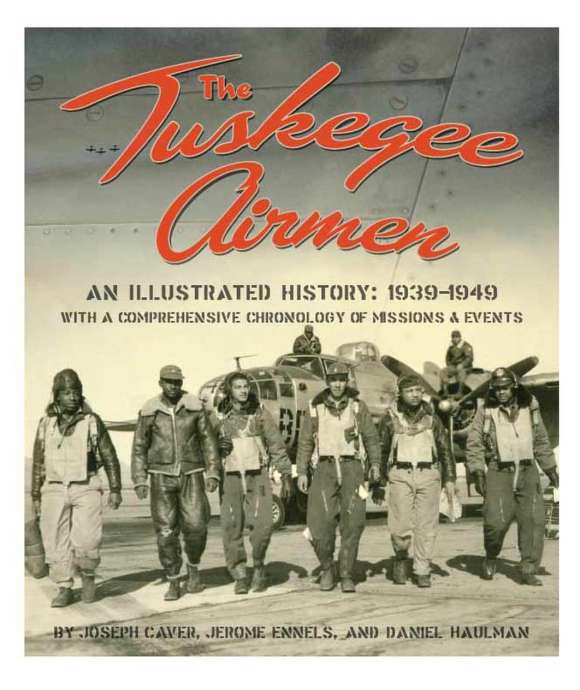
The Tuskegee Airmen, An Illustrated History: 1939-1949
Air Force historians Joseph Caver, Jerome Ennels, and Daniel Haulman chronicle the journey of the Airmen, including their training and combat missions through nearly 300 captioned era photographs, many never before published.
Jeremy Collins
Jeremy Collins joined The National WWII Museum in 2001 as an intern, and now oversees the institution’s public programming initiatives.
Cite this article:
MLA Citation:
APA Citation:
Chicago Style Citation:
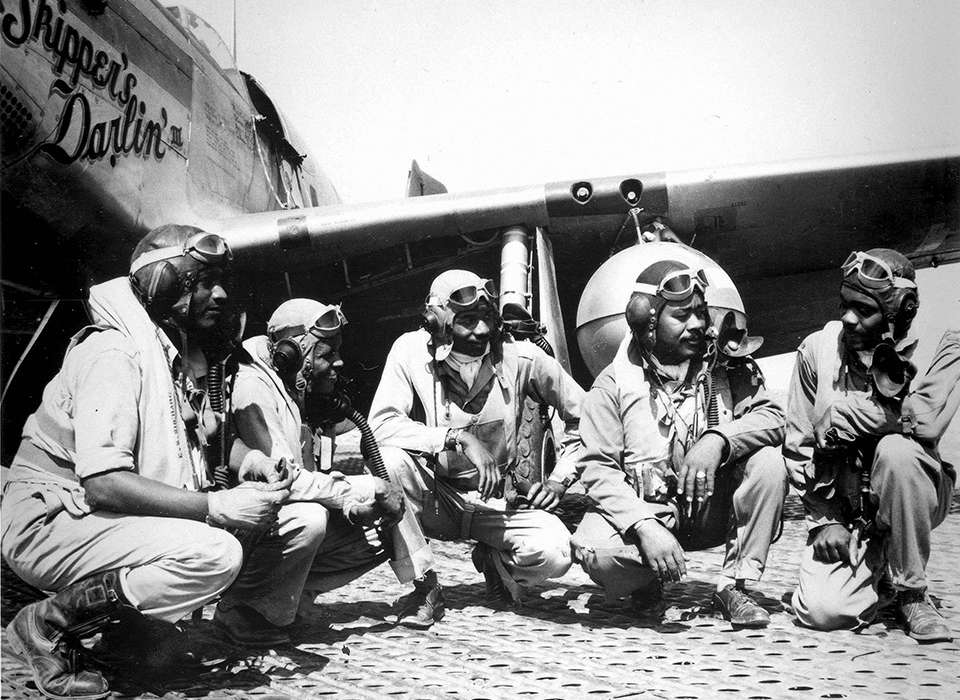
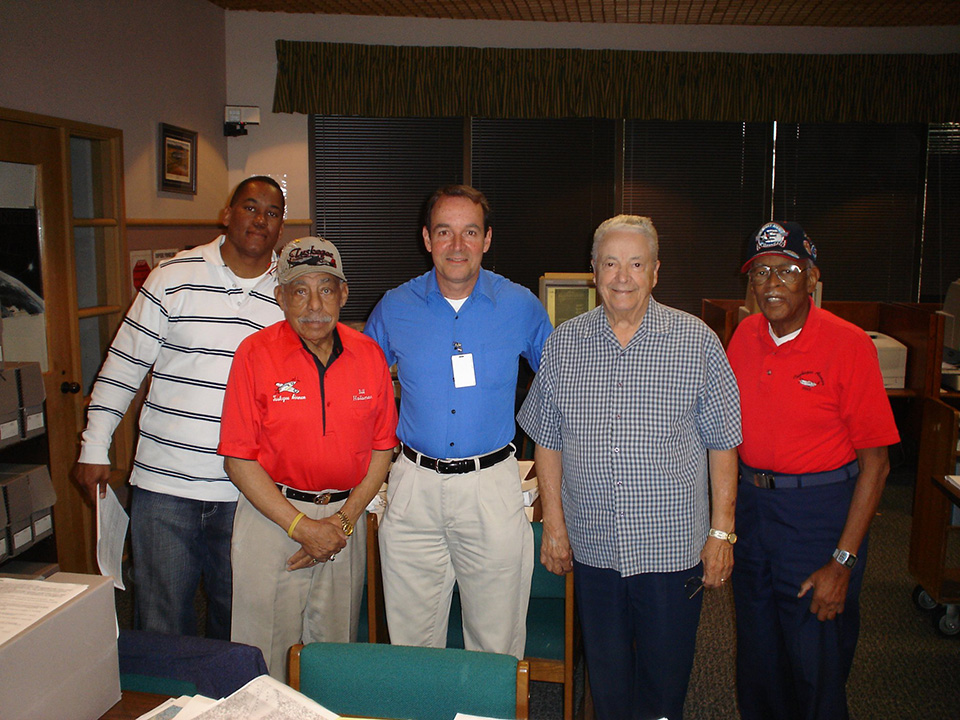
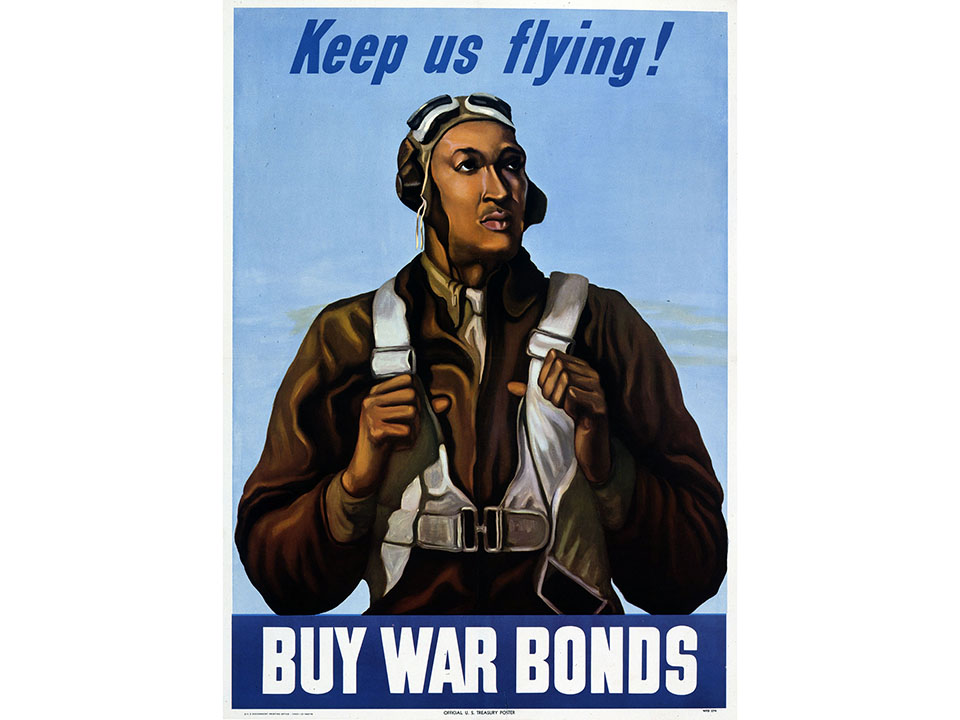
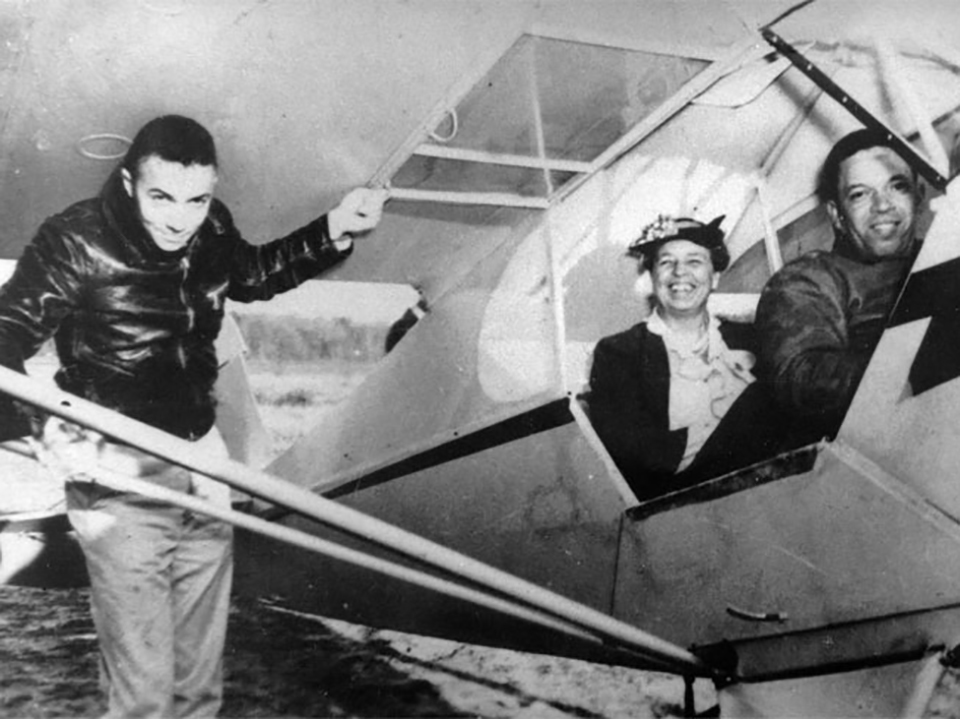
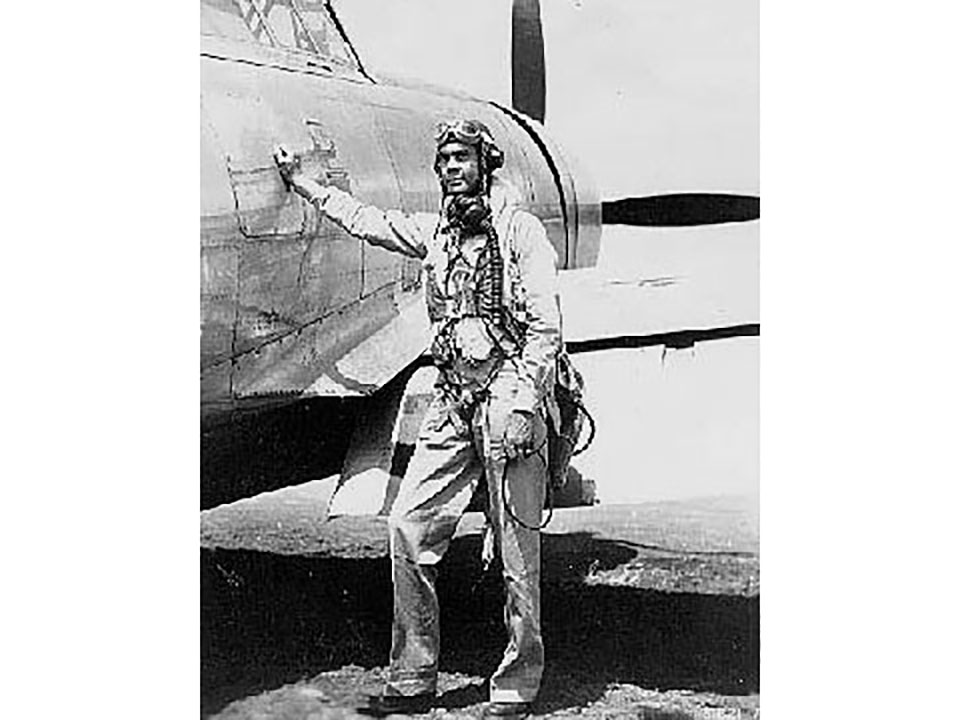
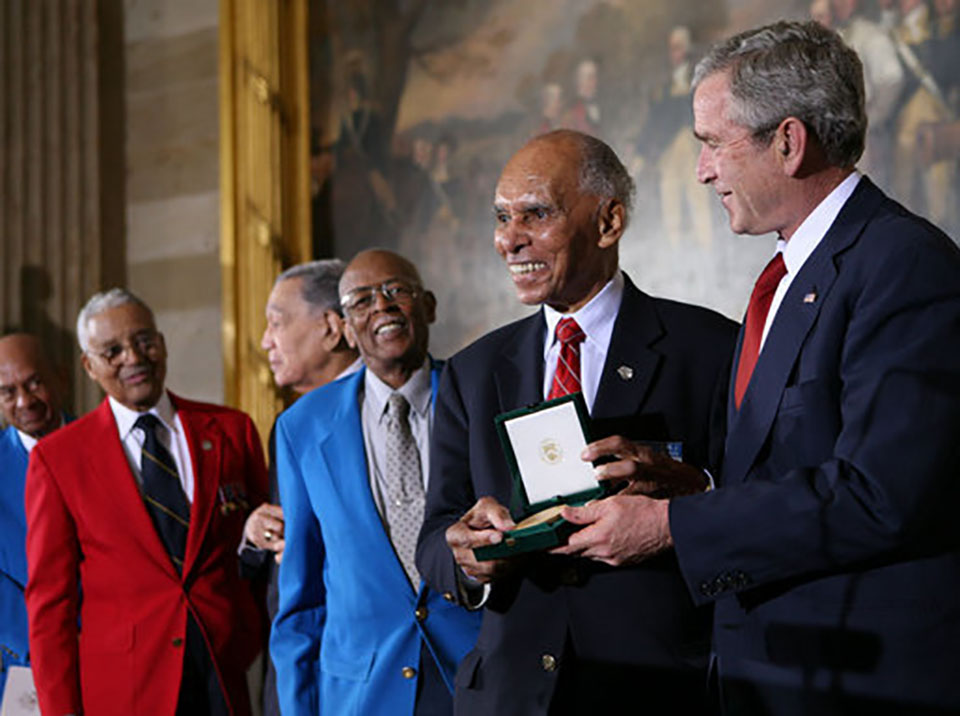
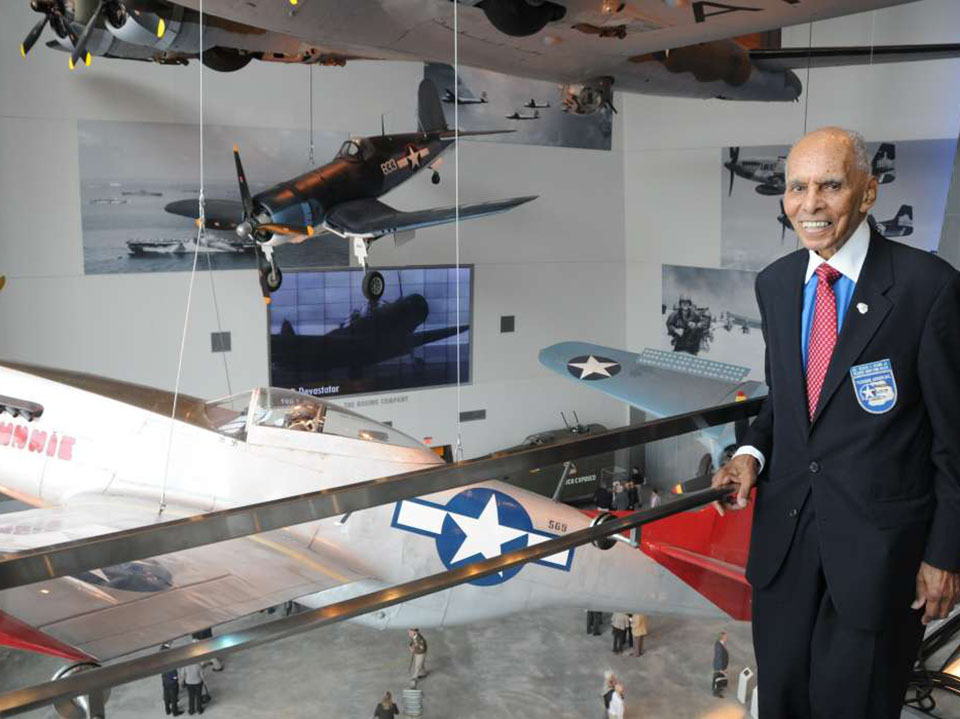





![Max Fuchs, New York City cantor, sings as Rabbi Sydney [sic] Lefkowitz, Richmond, VA, conducts the first Jewish services from Germany.](/sites/default/files/styles/max_650x650/public/2025-10/image1.jpg)


